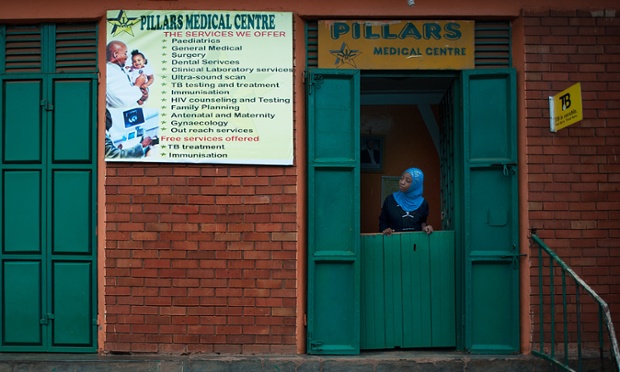
It is common for patients to arrive at Dr Kasauli Mahmoud Zinda’s private clinic in Bwaise, just north of Kampala’s humming business district, with a persistent cough, little appetite and a fever that, even after various treatments, just will not break. Zinda knows the symptoms usually add up to tuberculosis. With itinerant residents crowded into poorly ventilated homes and shops, the conditions in the impoverished neighbourhood are ideal for transmitting the disease.
But when he first opened the clinic, Pillars Medical Centre, in 2003, there was little Zinda could do about the suspected cases. “We didn’t have the laboratory knowhow, we didn’t have the expertise to actually identify the TB cases,” he said. As a private clinic it also did not receive any support from the ministry of health. National TB funding is mostly funnelled through public and non-profit facilities. Zinda was simply left “to guess” and then refer suspected patients to a nearby government facility for follow-up.
Zinda felt he was failing his community each time a probable TB patient walked out of his clinic without being tested, in all likelihood to spread the disease. So when representatives from the International Union Against Tuberculosis and Lung Disease approached him in 2011 to join a new initiative that would equip Pillars to test for and treat TB, “it looked like it was a dream,” he said.
The initiative – the Slum Partnerships to Actively Respond to Tuberculosis in Kampala (Spark-TB) – recognised that Uganda, one of the world’s 22 high-burden TB countries, needed new approaches to reach probable patients. “There are so many other people in the communities who remain undetected,” said Dr Anna Nakanwagi-Mukwaya, the union’s country representative. “The slums are one of those areas that have undetected TB patients.”
Along with Pillars, the union signed up 69 other private health facilities scattered across Kampala’s poorer urban areas, offering them equipment and intensive training, partnering them with public facilities and, eventually, facilitating access to national programmes that provide TB drugs free to patients. These centres became the frontline in the city’s fight to stop the disease’s spread. And their success has inspired the government to begin expanding the programme.
Uganda expects to have 60,000 new TB cases annually, said Dr Frank Mugabe, who heads the country’s National Tuberculosis and Leprosy Programme (NTLP), though health workers only diagnose around 44,000 patients each year. “We are not finding all the cases that we should be finding,” he said. “So as a country, we are struggling to control tuberculosis.”
Mugabe attributes that to several factors, including a general lack of public awareness about the disease and little commitment from political leaders to increase that knowledge. “If we don’t get the voice of the leaders, people are likely not to think that TB is a big problem,” he said.
There is also a perpetual funding shortage. Last year, 81% of the country’s national TB programme was completely unfunded, according to the World Health Organisation. The shortfall is why, said Nakanwagi-Mukwaya, “important sectors, like the private sectors, were often left out” of the response. This is a particularly harmful omission, because it is “the small, private, for-profit facilities that are used by the majority of the poor people in urban areas” – the same people most at risk of contracting TB.
More than half of Uganda’s urban residents turn first to private clinics when they get sick, according to government statistics, rather than contend with drug and staff shortages at free, government-run facilities.
Zinda said the results at his clinic were immediate. In 2012, the first year of the partnership, Pillars diagnosed 21 patients with TB. Last year that number grew to 45. They were all started on treatment. “We know the regimens now. We know which people need to get which regimens,” he said. Across all of the Spark-TB-trained facilities, the number of TB cases diagnosed increased from 666 in the first year of the programme to 1,059 in the second.
The organisers tried to shepherd more people showing potential symptoms into facilities. That meant shoring up knowledge of TB among village health team volunteers – community members who have local awareness and monitor their neighbours for symptoms.
One of those volunteers, John Kisembo, said that he “found in the community that people didn’t know what is TB and people were only reaching [health services] at a severe point”. That is slowly changing. Basic knowledge of the symptoms of TB jumped from 37% in an initial 2011 survey of Kampala to 80% when a follow-up survey was conducted last year.
Nakanwagi-Mukwaya said Spark-TB was “an eye opener,” especially for the ministry of health. “I think they realised that in order to increase the total number of TB cases found in the country, they cannot ignore the urban areas,” she said, nor the private clinics working there.
When the $980,000 Spark-TB project drew to a close last year, the ministry decided not only to take it over but to expand it. If an anticipated grant from the Global Fund to Fight Aids, TB and malaria comes through, the NTLP plans to roll out similar programmes in 10 additional urban centres by the end of the year.
“These facilities play a crucial role,” Mugabe acknowledged. “They are much closer to the communities. If given knowledge and helped, they can become a very firm bridge to the public and the community.”
Source: The Guardian